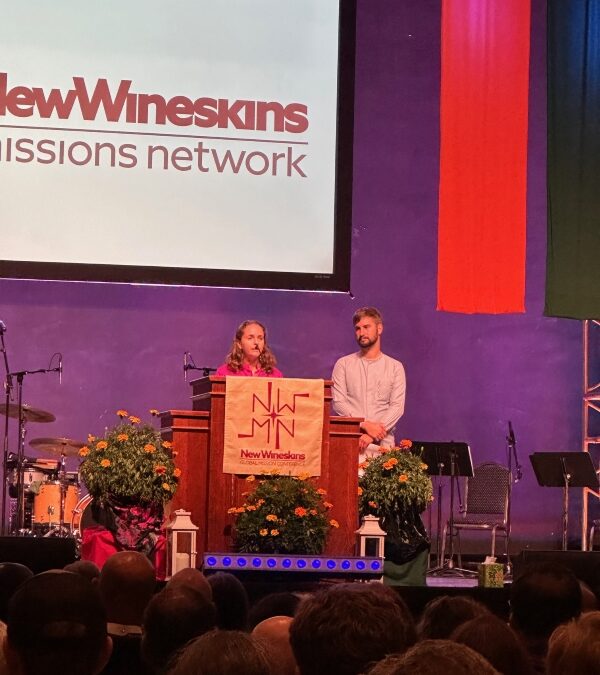
by Brendan Kimbrough | Oct 24, 2025 | SAMS Missionaries
By Wade and Chelsea Weeldreyer, SAMS Co-Directors of Missionary Care and Mission Engagement
In September, SAMS missionaries, senders, and staff gathered with 1,500 other Christians at the New Wineskins Hope for the Nations Conference in North Carolina. Over several days, we celebrated God’s redemptive work around the world and asked the Lord of the harvest to send more laborers into his field.
One simple refrain that emerged again and again, from plenary speakers to casual conversations, was this: God is on the move.
Indeed He is, and the 11th annual New Wineskins conference brought this into focus in fresh ways.
Here are a few glimpses of the ways that SAMS saw God on the move…
We saw God on the move as seasoned missionaries and individuals exploring missions shared meals together, shaping one another with questions, a listening ear, and times of sharing.
We saw God on the move as conference-goers stopped to chat at SAMS’ mission exhibit. The Spirit works through the ordinary, and many individuals stopped to connect with us because they noticed our world map, the coffee station, or, simply, a SAMS missionary practicing the ministry of presence.
We saw God on the move through our SAMS Celebration Dinner speakers – four missionaries who invited us to rejoice in how God is active in Europe, the U.S., North Africa, and Southeast Asia; and to imagine the ways in which God invites all of us to join Him in His global mission.
We saw God on the move through “divine appointments,” such as when a retired air traffic controller met a Southeast Asian global leader seeking someone to serve alongside the local church using exactly those skills. (Connections like these invite us into postures of prayerful curiosity about how God will move next!)
Finally, we saw God on the move through missional partnerships that already exist around the world. Through these partnerships, members of the body of Christ can gift one another with mutual discernment, encouragement, and joy.
In step with this, we welcome you to join SAMS in prayer in the following ways:
- Pray that missionary inquirers can move forward in mutual discernment with their home churches, with a sending organization such as SAMS, and with a receiving church wherever God leads.
- Pray that missionaries will continue to receive encouragement from the conversations, prayers, and interactions that they experienced at New Wineskins.
- Pray that senders experience much joy in their refreshed and increased connection with missionaries and the workings of God’s mission around the globe.
If you were at New Wineskins this year, we hope that you, too, are reflecting on the ways in which you sensed God on the move. Perhaps you experienced a renewed sense of discernment, encouragement, or joy along the way. We pray that the Lord meets you and blesses you where you are. And, if you were not at this year’s conference, you may decide to mark your calendar for the next one: September 20-23, 2028!

by Brendan Kimbrough | Oct 3, 2025 | Netherlands, SAMS Missionaries, The Church and Evangelism
by Johann Vanderbijl, SAMS Missionary, pastor and author serving in the Netherlands
What causes people who have once known the power and presence of the living God to stop following Him?
Moses warned Israel that it begins with complacency. When God’s people forget to honor Him as Father and Creator, they slowly relegate Him to the sidelines of life. That is not only Israel’s story—it is Europe’s story. Once the cradle of the Reformation, Europe is now a mission field. And the Netherlands, where my wife Louise and I serve, is a vivid example of what happens when nations that once knew God slowly forget Him.
The Spiritual Reality in the Netherlands
A few snapshots paint the picture clearly:
- Islam is growing: In 2015, about 4.9% of the Dutch population were Muslims. By 2023, that number had risen to 6%.
- Evangelicals are few: Only about 4% of the Dutch population identify as Evangelical believers, most of them clustered in the “Bible Belt,” far from the province where we work.
- Religion is declining: In 2010, 55% of the Dutch population considered themselves religious. By 2023, that number had dropped to 42%.
- Young people are drifting: Two-thirds of 18–25-year-olds now identify as non-religious. In our church, teenagers often tell us they are the only Christians in their schools—and confessing Jesus is viewed as ‘social suicide’.
- Even among Christians, faith is shallow: Fewer than half of Protestants attend church monthly, and three-quarters of Roman Catholics rarely or never go.
In short: the Netherlands is religiously plural, spiritually restless, and largely post-Christian.
Why North Holland?
Nowhere is this more evident than in North Holland, where we live and serve. This province has a rich spiritual history. Haarlem was home to Corrie Ten Boom. Alkmaar was the region of Brother Andrew. Missionaries like Willibrord and Boniface once brought the gospel to the Frisians here. Today, however, North Holland is one of the least churched provinces in the Netherlands. Many historic church buildings are no longer places of worship—they’ve become apartments, museums, cafés, or even breweries. They stand as silent symbols of a faith remembered but not lived. On a typical Sunday in our region, a church service might draw only a handful of elderly members. The younger generation—our neighbors, our children’s friends—are growing up without ever hearing the gospel in a meaningful way.
Why This Matters
So why Europe? Why North Holland? Because if the gospel is truly good news for all people, then it is also good news for Europeans—people who once carried the gospel across the globe, but who are now in desperate need of hearing it again.
The spiritual hunger is real:
- Loneliness is rising, especially among young people, often leading to anxiety, depression, and fear.
- Suicide is now the leading cause of death among Dutch teens and young adults. The number of youth seeking help for suicidal thoughts has risen by 75%.
Europe doesn’t just need nostalgia for a Christian past. It needs Jesus today.
Our Role—and How You Can Join Us
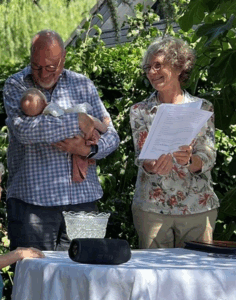
In North Holland, we meet people who are spiritually curious but biblically illiterate. Young adults who have never opened a Bible. Families searching for identity in everything but Christ. People who believe everything—and nothing. We cannot change this landscape alone. But we also cannot ignore it. That’s why partnership matters. Your prayers, encouragement, and support are not simply “keeping missionaries on the field.” They are investments in re-evangelizing a province, a nation, and a continent that has forgotten its first love.
Hope for Europe
So I return to the opening question: What causes people to stop following God? It happens slowly—through complacency, compromise, forgetting, and replacing Him with lesser gods. But what can bring them back? The faithful witness of God’s people, boldly proclaiming that Jesus Christ is Lord—not only of history, not only of other nations, but also of the Netherlands, of North Holland, of every street, family, and heart where His name has been forgotten. We believe God is not finished with Europe. Revival is possible. But it begins when God’s people take seriously the call to go, to give, to pray, and to serve. That’s why we’re here. And that’s why we invite you to join us—so that the gospel will not only be Europe’s past, but also Europe’s future.
Resources:
https://oakriverpress.com/products/patw/europe/europe-full-small.pdf
https://oakriverpress.com/
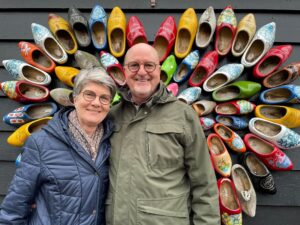
Johann and Louise VanderBijl are SAMS Missionaries serving in the north Holland city of Heiloo. Johann’s missionary roots trace back to his Great-Grandfather – an Anglican missionary in Southern Africa. The Lord revealed His love and purpose to Johann in 1980 through the witness of an unrelated missionary. Since then, his personal salvation impressed upon him the need to share with others the wonderful gift given to him, especially those lost in their own misfortunes. Johann and Louise met while they were both serving in Northwestern Namibia. Together, they try to seek first His kingdom and His righteousness in whatever God has called them to do. Johann has authored several books which can be found under the Langham Publishing imprint.
For further information and how you can support the VanderBijl’s cross-cultural work visit their SAMS page and their blog.
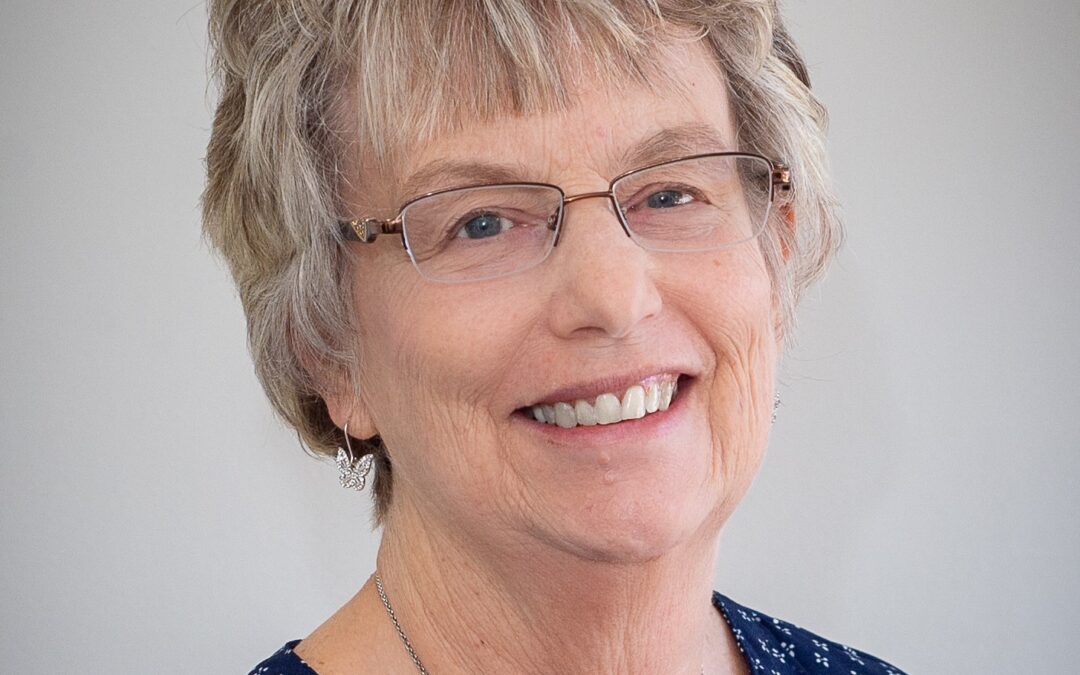
by Brendan Kimbrough | Jul 23, 2025 | SAMS Missionaries
The Society of Anglican Missionaries and Senders (SAMS) gives thanks to the Lord for the ministry of Denise Cox who has encouraged your Missionaries in their holy callings and equipped the church and other Senders to come alongside these cross-cultural servants. Countless Missionaries and Senders have reflected this gratitude in Christ through letters and calls of appreciation (See a few excerpts below).
Stewart Wicker, SAMS Mission Director, commended Denise’s ministry, “Her contributions and sacrifices over 36 years have furthered each and every aspect of our Society’s mission to share the love of Jesus across cultures in fellowship with the global Anglican church. Your Society has grown through her gifting, as well as through her enormous commitment and perseverance to serve missionaries and the church.”
Denise will continue to contribute to the mission of SAMS through a transitional part-time ministry role. Her primary focus will be the launching of a new position which will be filled by new SAMS Home Staff Team Missionaries Wade and Chelsea Weeldreyer who will share the responsibilities of caring for your Missionaries and encouraging Senders.
Your prayers for Denise’s next steps in this new stage of life as well as for her husband Phil and extended family are valued!
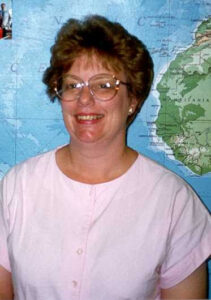
Denise in 1989
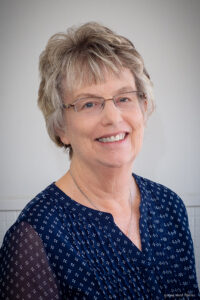
Denise in 2025
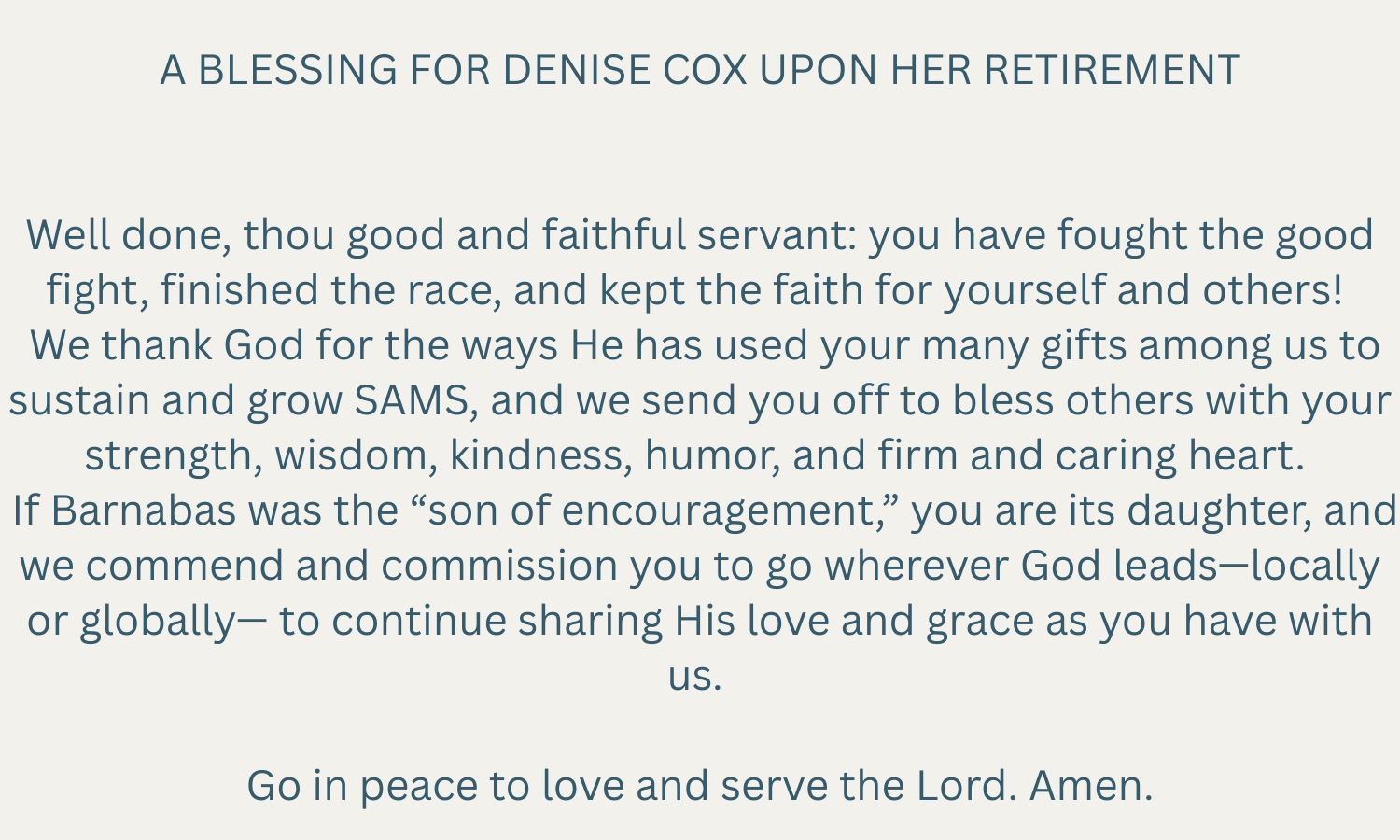
Excerpts from a few of the letters received from Missionaries
Thank you for being such a steady hand, guiding us as missionaries, speaking truth, but also giving us ideas, and confidence. God has used you to not only help us get started in missions but to sustain us over the years.
— Dave and Lucy Chaves
I’m grateful for your wisdom, fantastically dry humor, and godly leadership. You always had time for me.
— Jessica Hughes
[We thank God for] LONG phone conversations where you did almost all the listening and just let us unload, and through it all, your unceasing support in prayer for us, our family, even our extended family! You always had time for us, even if you had a million other things to do. Denise, you gave selflessly over these years and we are very grateful.
— Russ and Heidi Smith
If the works Denise has done are of an invisible kind that we cannot lay out like tunics and garments for display, they are no less real, and enduring, and treasured. That her blood, sweat and tears poured out for the kingdom, its workers, and the world, have been gold, silver and precious stones is for heaven to announce on that Day.
— Jim and Nanci Long
As the song goes: “There’ll never, ever, ever be another you.” We love you, Denise.
— Richard and Martha Menees.
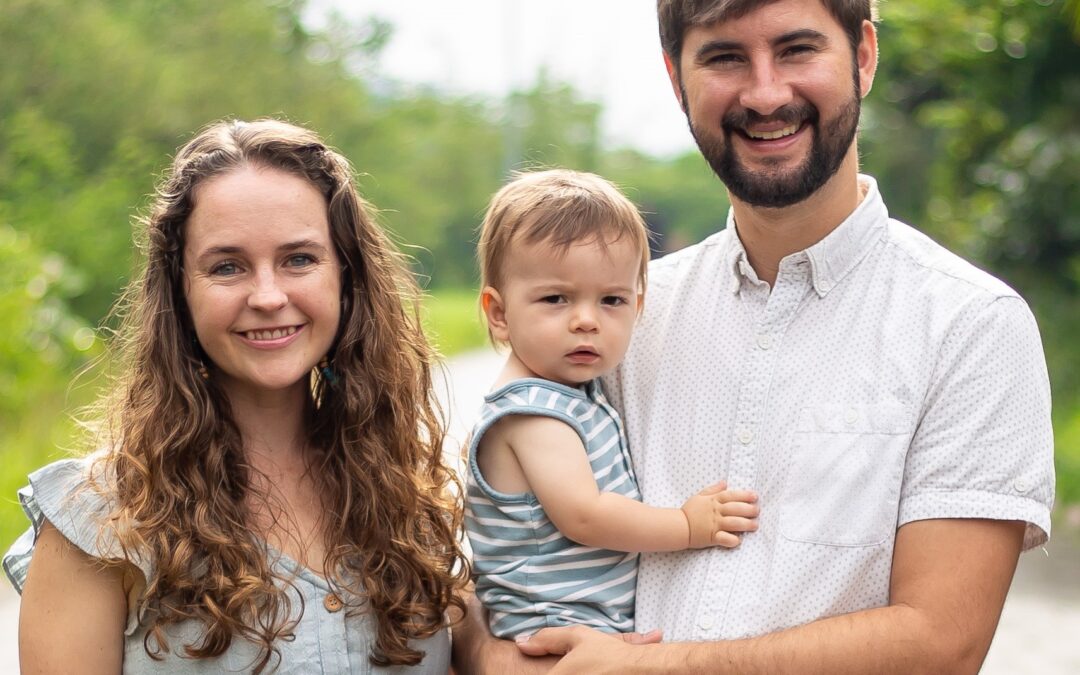
by Brendan Kimbrough | Jun 14, 2025 | SAMS Home Staff, SAMS Missionaries
Society Catalyzing Growth in Sending and Supporting Missionaries
by Stewart Wicker, SAMS President and Mission Director
This summer SAMS is undergoing some exciting transformations, and by God’s grace our capacity is growing. SAMS Missionaries Wade and Chelsea Weeldreyer are joining the home staff and are launching into a new ministry in their role as Co-Directors of Missionary Care and Mission Engagement. The Co-Directors will empower potential missionaries, candidates, and missionaries to join with God in His global mission. They will also resource Anglican Churches as they raise up and send these missionaries throughout the world.
As Co-Directors, the Weeldreyers will be focused on missionaries, supporting the servants who share the Gospel of Jesus Christ in word and deed across cultures. They will also seek to encourage churches and all senders to go deeper in their mission callings.Wade and Chelsea bring complementary gifts and experiences to this role combined with a clear passion to multiply ministry through fostering missionaries who make disciples of Jesus, who, in turn will make more disciples.
Wade and Chelsea concluded their initial missionary term in Kigali, Rwanda, two weeks ago. Wade served as a lecturer at the theological college of the Anglican Church of Rwanda. Chelsea came alongside the Rwandan-led ministry Word Made Flesh, reaching out to vulnerable women and children in the name of Christ. Wade holds a Master of Divinity and Chelsea a Master of Arts in Intercultural Studies. They both have international experience beyond Rwanda–and met each other in Israel in 2015. They were sent by their church in Highwood, IL, in 2022 with their one-year-old daughter Evelyn. Now “Evie” has a one-year-old brother William.
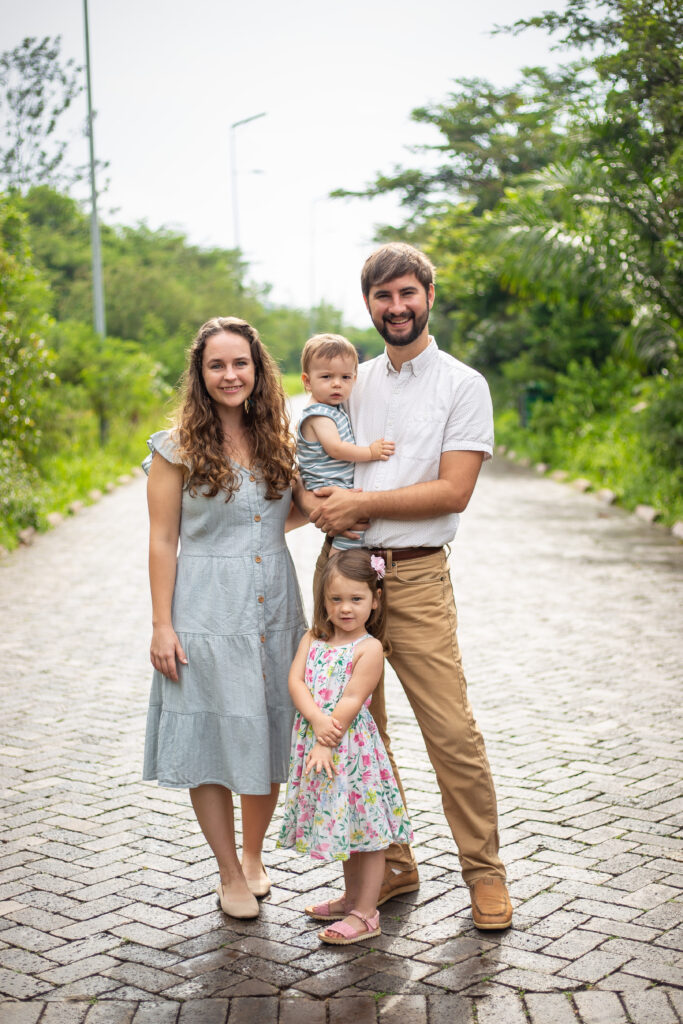
Wade and Chelsea will complete a brief Home Ministry Assignment and begin their second missionary term with your Society in their new role on August 1, serving as Missionaries on the Home Staff Team.
Learn more about Wade and Chelsea in this feature article of SAMS Messenger
Consider supporting Wade and Chelsea’s missionary ministry on SAMS Home Staff Team
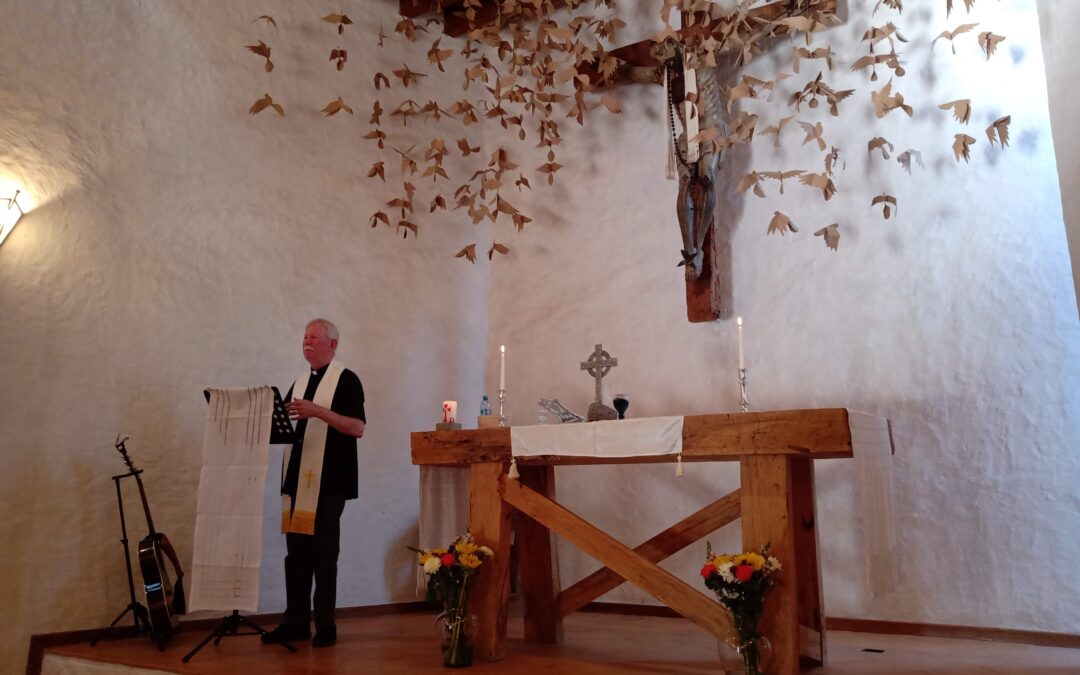
by Roger and Joanne Griffin | May 15, 2025 | SAMS Missionaries
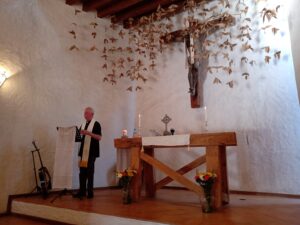
We never know where the Lord may lead us, but through an intercontinental rabbit trail involving Coloradans with relatives in Mexico, messages to GAFCON in Africa, then to ACNA in the U.S., to Bishop Tighe in the Diocese of the Southwest, to a clergy retreat in Santa Fe, NM, to a business card left in my purse for 2 weeks before someone reminded me (whew!)– we are grateful to God for completing the connection! He led us to the city of San Miguel de Allende in Guanajuato, Mexico, to worship with a group of ex-pats there. After we made contact, had a Zoom call, and agreed to drive the three hours to San Miguel, the group there assembled the funds to rent a lovely little chapel last Wednesday evening. May is a sweltering hot month, but we were 23 people together, excited at this kickoff of what may be a new Anglican Church in Mexico. It gave us a chance to make new friends, and the privilege to worship the Lord in our native language. Praise be to God! We are returning at the end of May to lead two services, one in English and one in Spanish, as there was much interest within the Mexican community.
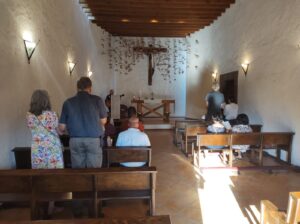 Please be in prayer for this small, but dedicated group of Anglicans who are exploring the possibility of forming a congregation for the glory of the Lord and the extension of His kingdom in Mexico.
Please be in prayer for this small, but dedicated group of Anglicans who are exploring the possibility of forming a congregation for the glory of the Lord and the extension of His kingdom in Mexico.
Last week we also ministered in Fresnillo, Zacatecas, and provided free tacos for Mother’s Day after the service. Tomorrow, May 16, we head out for a two-week driving circuit, visiting churches in the city of Puebla, and in Xalapa, Veracruz. On the way back we will stop again for the group in San Miguel de Allende. Please pray for our safety as we travel the Mexican highways, and for the churches in Mexico that are forming under the challenges of economy, safety, and uncertainty. Pray also for the local church here in Aguascalientes as it restarts with a new generation of families. We are grateful to be a small part of the work of the Gospel through SAMS, and blessed to read the blogs of others here and realize how great is our God!
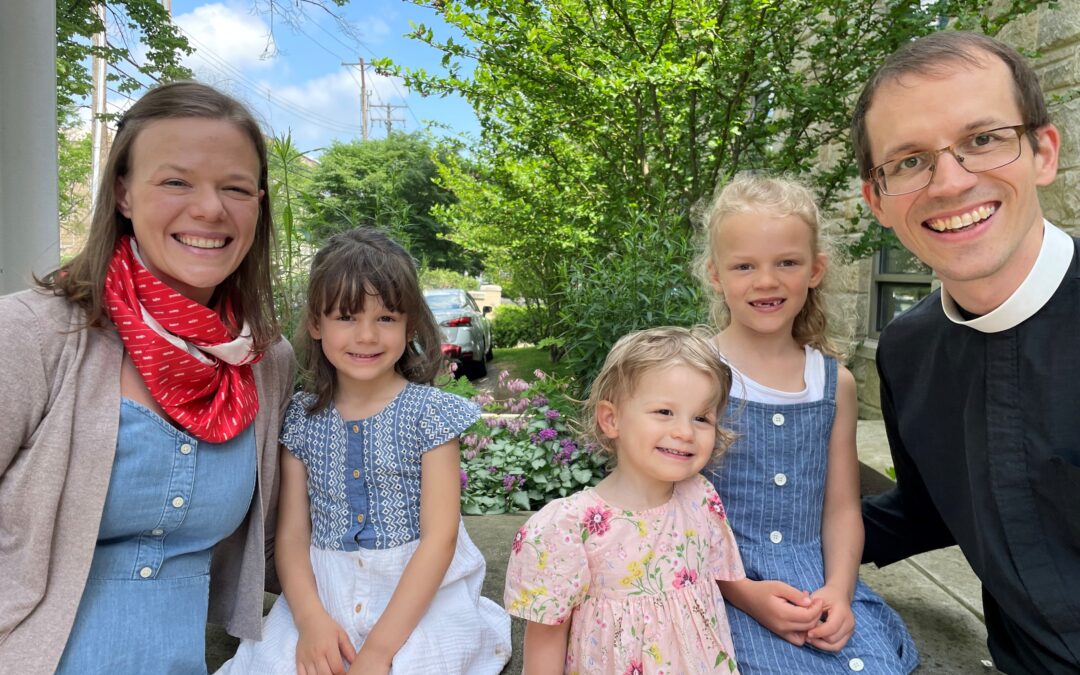
by Brendan Kimbrough | Mar 20, 2025 | Immigrant Ministry, SAMS Missionaries
by Daniel and Rebekah Behrens, SAMS Missionaries in the U.S.
“It was the best of times, it was the worst of times…it was the season of Light, it was the season of Darkness, it was the spring of hope, it was the winter of despair.”
These famous words begin Charles Dickens’ A Tale of Two Cities and they come to mind when I reflect on the stark contrasts we have seen during the season of Epiphany. We want to share honestly about both the darkness and the light, with the assurance that Jesus gives: “The light shines in the darkness, and the darkness has not overcome it” (John 1:5).
The Season of Darkness
On his first day in office, President Trump halted the United States Refugee Admissions Program. Flights were cancelled even for families who were fully vetted and had been waiting for years for a fresh start. This was painful to see, but not a surprise.
Days later the State Department issued an unexpected “Stop Work” order to organizations that resettle refugees. This meant that refugee families who had arrived in November, December, and January were left without the support which the U.S. government had promised them. The first 90 days are a critical time where agencies help families struggle for stability (learning how to ride the bus, finding groceries, signing up for school, finding a job, etc). In the best of circumstances, this is a huge effort for the agency and a massive adjustment for the family. Suddenly, agencies across the country had the rug pulled out from them. In Pittsburgh, they reeled to adjust, laying off staff, re-assigning families to other programs, and putting out pleas for volunteer help and financial support.
Let me say here that I am in favor of reforms to the way immigration to the U.S. happens. There is much we can and should debate and reform. But refugee resettlement is a model of regulated, legal immigration for families who do not have the option of returning to their home countries. To halt resettlement and cut support without warning to vulnerable families we have already invited into our communities is a level of barbarity which still makes me shake with anger and bow my head in shame.
The Season of Light
Where have we seen the light in the midst of this darkness? Because of our existing relationship with Hello Neighbor, one of the resettlement agencies in Pittsburgh, Church of the Ascension was positioned to respond quickly. Within days of the “Stop Work” order our senior pastor shared a request with the congregation for gift cards to help purchase groceries for families who were still in temporary housing. We, in partnership with another missionary couple within Ascension, extended an invitation for congregants to form a “Rapid Response Team” (RRT) to meet needs in our area. The congregation responded with overwhelming generosity. Over 50 people came to an informational meeting to learn more about the RRT and we received thousands of dollars in gift cards.
Within days, the RRT was on the move – picking up groceries, driving people to the grocery store, or showing them how to use the bus. In the weeks since then, our efforts have included setting up a home, gathering and delivering furniture, driving to medical appointments, providing English learning resources, sharing clothing, playing at a park, going to the library, and simply visiting and drinking tea. We have focused on about a dozen recently-arrived families from the Congo, South Sudan, Eritrea, Honduras, and Afghanistan. The resettlement agencies have had to continue laying off staff and making hard adjustments as it becomes clear that federal support is likely to stop for a prolonged time. In the midst of this darkness, it has been an absolute honor to see God’s people rising to the occasion. Their joy and sacrifice bolster our faith that God is still at work.
Thank you!
Read more about Daniel and Rebekah Behren’s ministry to immigrants and how you can support them and the immigrants they serve here.
|
GIVE
Ascension has started a Refugee Relief fund. Money from that account is being used to care for the 12-14 families with whom we have connected. If you would like to contribute, click here and select “Refugee Relief” in the drop-down menu. |
|
|
CONSIDER YOUR NEIGHBORS
Where in your neighborhood are there refugee families or resettlement agencies that you can support financially or through volunteering? This situation is not unique to Pittsburgh so we encourage you to get involved locally. Particularly during this season of Lent, have your eyes open to see others around you who may be hurting or needy and ask God to guide your words and actions. |
|













 Please be in prayer for this small, but dedicated group of Anglicans who are exploring the possibility of forming a congregation for the glory of the Lord and the extension of His kingdom in Mexico.
Please be in prayer for this small, but dedicated group of Anglicans who are exploring the possibility of forming a congregation for the glory of the Lord and the extension of His kingdom in Mexico.